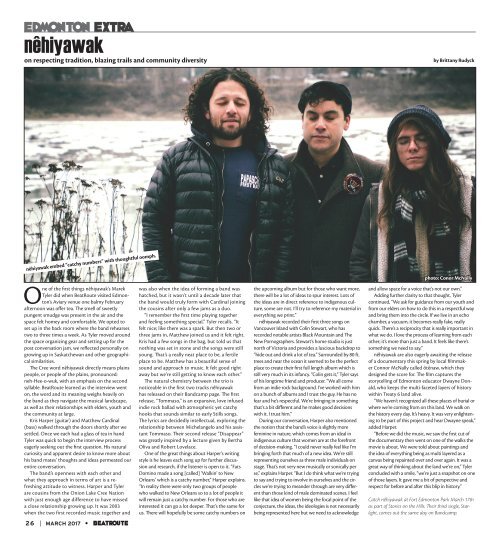BeatRoute Magazine AB print e-edition - March 2017
BeatRoute Magazine: Western Canada’s Indie Arts & Entertainment Monthly BeatRoute (AB) Mission PO 23045 Calgary, AB T2S 3A8 E. editor@beatroute.ca BeatRoute Magazine is a monthly arts and entertainment paper with a predominant focus on music – local, independent or otherwise. The paper started in June 2004 and continues to provide a healthy dose of perversity while exercising rock ‘n’ roll ethics. Currently BeatRoute’s AB edition is distributed in Calgary, Edmonton (by S*A*R*G*E), Banff and Canmore.
BeatRoute Magazine: Western Canada’s Indie Arts & Entertainment Monthly
BeatRoute (AB)
Mission PO 23045
Calgary, AB
T2S 3A8
E. editor@beatroute.ca
BeatRoute Magazine is a monthly arts and entertainment paper with a predominant focus on music – local, independent or otherwise. The paper started in June 2004 and continues to provide a healthy dose of perversity while exercising rock ‘n’ roll ethics.
Currently BeatRoute’s AB edition is distributed in Calgary, Edmonton (by S*A*R*G*E), Banff and Canmore.
You also want an ePaper? Increase the reach of your titles
YUMPU automatically turns print PDFs into web optimized ePapers that Google loves.
EDMONTON EXTRA<br />
nêhiyawak<br />
on respecting tradition, blazing trails and community diversity<br />
by Brittany Rudyck<br />
nêhiyawak embed “catchy numbers” with thoughtful oomph.<br />
photo: Conor McNally<br />
One of the first things nêhiyawak’s Marek<br />
Tyler did when <strong>BeatRoute</strong> visited Edmonton’s<br />
Aviary venue one balmy February<br />
afternoon was offer tea. The smell of sweetly<br />
pungent smudge was present in the air and the<br />
space felt homey and comfortable. We opted to<br />
set up in the back room where the band rehearses<br />
two to three times a week. As Tyler moved around<br />
the space organizing gear and setting up for the<br />
post conversation jam, we reflected personally on<br />
growing up in Saskatchewan and other geographical<br />
similarities.<br />
The Cree word nêhiyawak directly means plains<br />
people, or people of the plains, pronounced:<br />
neh-Hee-o-wuk, with an emphasis on the second<br />
syllable. <strong>BeatRoute</strong> learned as the interview went<br />
on, the word and its meaning weighs heavily on<br />
the band as they navigate the musical landscape,<br />
as well as their relationships with elders, youth and<br />
the community at large.<br />
Kris Harper (guitar) and Matthew Cardinal<br />
(bass) walked through the doors shortly after we<br />
settled. Once we each had a glass of tea in hand<br />
Tyler was quick to begin the interview process<br />
eagerly seeking out the first question. His natural<br />
curiosity and apparent desire to know more about<br />
his band mates’ thoughts and ideas permeated our<br />
entire conversation.<br />
The band’s openness with each other and<br />
what they approach in terms of art is a refreshing<br />
attitude to witness. Harper and Tyler<br />
are cousins from the Onion Lake Cree Nation<br />
with just enough age difference to have missed<br />
a close relationship growing up. It was 2003<br />
when the two first recorded music together and<br />
was also when the idea of forming a band was<br />
hatched, but it wasn’t until a decade later that<br />
the band would truly form with Cardinal joining<br />
the cousins after only a few jams as a duo.<br />
“I remember the first time playing together<br />
and feeling something special,” Tyler recalls. “It<br />
felt nice; like there was a spark. But then two or<br />
three jams in, Matthew joined us and it felt right.<br />
Kris had a few songs in the bag, but told us that<br />
nothing was set in stone and the songs were still<br />
young. That’s a really neat place to be, a fertile<br />
place to be. Matthew has a beautiful sense of<br />
sound and approach to music. It felt good right<br />
away but we’re still getting to know each other.”<br />
The natural chemistry between the trio is<br />
noticeable in the first two tracks nêhiyawak<br />
has released on their Bandcamp page. The first<br />
release, “Tommaso,” is an expansive, love infused<br />
indie rock ballad with atmospheric yet catchy<br />
hooks that sounds similar to early Stills songs.<br />
The lyrics are decidedly intellectual, exploring the<br />
relationship between Michelangelo and his assistant<br />
Tommaso. Their second release “Disappear”<br />
was greatly inspired by a lecture given by Bertha<br />
Oliva and Robert Lovelace.<br />
One of the great things about Harper’s writing<br />
style is he leaves each song up for further discussion<br />
and research, if the listener is open to it. “Fats<br />
Domino made a song [called] ‘Walkin’ to New<br />
Orleans’ which is a catchy number,” Harper explains.<br />
“In reality there were only two groups of people<br />
who walked to New Orleans so to a lot of people it<br />
will remain just a catchy number. For those who are<br />
interested it can go a lot deeper. That’s the same for<br />
us. There will hopefully be some catchy numbers on<br />
the upcoming album but for those who want more,<br />
there will be a lot of ideas to spur interest. Lots of<br />
the ideas are in direct reference to indigenous culture,<br />
some are not. I’ll try to reference my material in<br />
everything we <strong>print</strong>.”<br />
nêhiyawak recorded their first three songs on<br />
Vancouver Island with Colin Stewart, who has<br />
recorded notable artists Black Mountain and The<br />
New Pornographers. Stewart’s home studio is just<br />
north of Victoria and provides a luscious backdrop to<br />
“hide out and drink a lot of tea.” Surrounded by 80 ft.<br />
trees and near the ocean it seemed to be the perfect<br />
place to create their first full length album which is<br />
still very much in its infancy. “Colin gets it,” Tyler says<br />
of his longtime friend and producer. “We all come<br />
from an indie rock background. I’ve worked with him<br />
on a bunch of albums and I trust the guy. He has no<br />
fear and he’s respectful. We’re bringing in something<br />
that’s a bit different and he makes good decisions<br />
with it. I trust him.”<br />
During our conversation, Harper also mentioned<br />
the notion that the band’s voice is slightly more<br />
feminine in nature, which comes from an ideal in<br />
indigenous culture that women are at the forefront<br />
of decision-making. “I could never really feel like I’m<br />
bringing forth that much of a new idea. We’re still<br />
representing ourselves as three male individuals on<br />
stage. That’s not very new musically or sonically per<br />
se,” explains Harper. “But I do think what we’re trying<br />
to say and trying to involve in ourselves and the circles<br />
we’re trying to meander through are very different<br />
than those kind of male dominated scenes. I feel<br />
like that idea of women being the focal point of the<br />
conjecture, the ideas, the ideologies is not necessarily<br />
being represented here but we need to acknowledge<br />
and allow space for a voice that’s not our own.”<br />
Adding further clarity to that thought, Tyler<br />
continued, “We ask for guidance from our youth and<br />
from our elders on how to do this in a respectful way<br />
and bring them into the circle. If we live in an echo<br />
chamber, a vacuum, it becomes really fake, really<br />
quick. There’s a reciprocity that is really important in<br />
what we do. I love the process of learning from each<br />
other; it’s more than just a band. It feels like there’s<br />
something we need to say.”<br />
nêhiyawak are also eagerly awaiting the release<br />
of a documentary this spring by local filmmaker<br />
Connor McNally called ôtênaw, which they<br />
designed the score for. The film captures the<br />
storytelling of Edmonton educator Dwayne Donald,<br />
who keeps the multi-faceted layers of history<br />
within Treaty 6 land alive.<br />
“We haven’t recognized all these places of burial or<br />
where we’re coming from on this land. We walk on<br />
the history every day. It’s heavy. It was very enlightening<br />
to be part of this project and hear Dwayne speak,”<br />
added Harper.<br />
“Before we did the music, we saw the first cut of<br />
the documentary then went on one of the walks the<br />
movie is about. We were told about paintings and<br />
the idea of everything being as multi layered as a<br />
canvas being repainted over and over again. It was a<br />
great way of thinking about the land we’re on,” Tyler<br />
concluded with a smile, “we’re just a snapshot on one<br />
of those layers. It gave me a bit of perspective and<br />
respect for before and after this blip in history.”<br />
Catch nêhiyawak at Fort Edmonton Park <strong>March</strong> 17th<br />
as part of Stories on the Hills. Their third single, Starlight,<br />
comes out the same day on Bandcamp.<br />
26 | MARCH <strong>2017</strong> • BEATROUTE


















